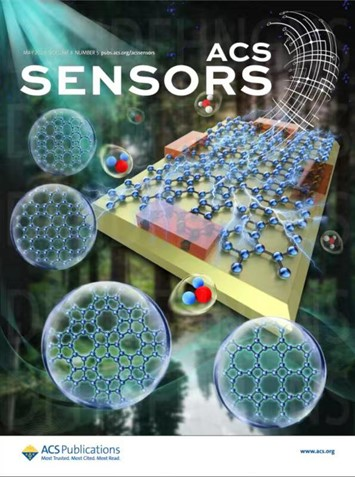Recently, Associate Professor Chen Tong of the Materials Discipline Group of the School of Energy and Mechanical Engineering and others have made important progress in functional all-carbon nano-gas sensing devices, and the research results are "A Comparative Study of the Electronic Transport and Gas-Sensitive Properties of Graphene+, T-graphene, Net-graphene, and." Biphenylene-Based Two-Dimensional Devices" was selected as the cover published in the internationally important academic journal "ACS Sensors". Xie Luzhen, a 21-level graduate student, is the first author, Associate Professor Chen Tong is the corresponding author, and Jiangxi University of Science and Technology is the first communication unit.

Journal: ACS Sensors Impact Factor: 8.9 Partition: Top in Zone 1
The diversity of carbon materials makes it possible to fabricate all-carbon electronic devices with different properties and functions. As one of the important topics of modern materials science, the research on graphene-based carbon materials and their applications has received extensive attention, and it will be very promising and interesting to study the transport and gas-sensitive properties of graphene+, T-graphene, Net-graphene and biphenyls. Combined with density functional theory and non-equilibrium Green's function, the electron transport properties of four carbon isomers, graphene+, T-graphene, Net-graphene and biphenyls, as well as the gas-sensitive properties of nitrogen-based gas molecules such as NO2, NO and NH3, were systematically studied and compared. All four carbon isomers exhibit metallic properties, in particular graphene+ is a Dirac metal because there are two Dirac cones at the Fermi level. Two-dimensional devices based on these four carbon isomers exhibit good conductivity in the order biphenyl> T-graphene> graphene + > Net-graphene. More interestingly, Net-graphene-based and biphenyl-based devices exhibit significant anisotropic transport characteristics. The gas sensors based on the above four structures have good selectivity and sensitivity to NO2 molecules, among which the T-graphene-based gas sensor is the most prominent, and its maximum ∆I is 39.98 uA, which is only three-fifths of the intrinsic device. In addition, graphene+-based and biphenyl-based gas sensors are also sensitive to NO molecules, with maximum ∆I values of 29.42 and 25.63 uA, respectively. However, all four gas sensors exhibit physical adsorption for NH3. The mechanisms behind all properties are clearly explained through adsorption energy, charge transfer, electron localization function, and orbital projection Hamiltonian. These four carbon materials have excellent electrical conductivity, high stability, high sensitivity, and good environmental tolerance, demonstrating their immeasurable potential for future gas sensor applications.
Literature webpage: https://pubs.acs.org/doi/abs/10.1021/acssensors.3c01087
